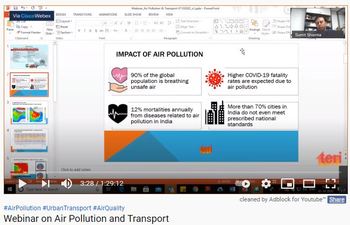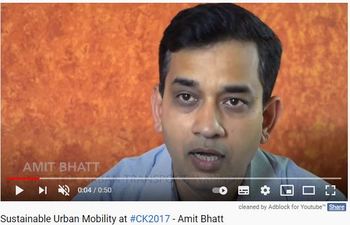Knowledge Hub
California’s Advanced Clean Trucks regulation: Sales requirements for zero-emission heavy-duty trucks
2020
Publisher/Organisation: International Council on Clean Transportation (ICCT)
On June 25, 2020, the California Air Resources Board (CARB) adopted the final rule for new standards that require the sale of zero-emission heavy-duty trucks (HDTs). The Advanced Clean Trucks (ACT) rulemaking finalizes standards that were initially proposed on October 22, 2019, and strengthened in a revised proposal on April 28, 2020. The regulation requires manufacturers to sell increasing percentages of zero-emission trucks, is expected to reduce the lifecycle emission of greenhouse gases (GHGs), eliminate tailpipe emissions of air pollutants, and foster a market for zero-emission HDTs. This HDT regulation is one of a series of rules that aim to advance climate and air quality strategies in California, which requires state-wide GHG reductions of 40% below the 1990 level by 2030. The sales requirements in the ACT are complemented by series of fleet purchase requirements, such as the Innovative Clean Transit rule for buses, which goes into effect in 2023 and requires 100% zero-emission bus purchases by 2029. This policy update summarizes key elements of the ACT rule and provides a regulatory context in California, the United States, and other major vehicle markets.
Charging forward on powering vehicles: economic and policy drivers for electric vehicle charging infrastructure in India – preliminary results
2020
Publisher/Organisation: Natural Resources Defense Council (NRDC)
In order to attract increased investments in charging infrastructure, policy interventions are needed that can improve the economics of EVs and charge, including reducing cost hurdles and other barriers. In the absence of government policies, insufficient charging infrastructure often presents a challenge for stakeholders. This factsheet presents recommendations on economic and policy drivers for scaling-up EV charging infrastructure to support a robust EV market in India for 2-wheelers, 3-wheelers, ride-hailing vehicles, and private buses. The preliminary results and findings presented in this factsheet are based on the model analysis of the Hyderabad EV ride-hailing taxi example. The analysis and policy recommendations from this example are indicative of the other vehicle segments. Since the analysis was conducted in 2019 and before the COVID-19 pandemic, some of the vehicle segment use cases have had reduced ridership, such as shared mobility and ride-hailing taxis.
China announced 2019 subsidies for new energy vehicles
2019
Publisher/Organisation: International Council on Clean Transportation (ICCT)
China’s Ministry of Finance, Ministry of Industry and Information Technology (MIIT), Ministry of Science and Technology, and National Development and Reform Commission on March 26, 2019, jointly released A Notice of Further Adjusting Fiscal Subsidies for Promoting New Energy Vehicles. A new energy vehicle (NEV) is a battery-electric, plug-in hybrid, or fuel cell vehicle, and the Notice provides a detailed formula to determine the subsidy due to consumers who buy a new battery electric or plug-in hybrid vehicle in 2019. The Notice outlines tightened requirements to qualify for the subsidy and provide a revised formula to determine the subsidy’s size. Further, it includes guidance regarding the paired incentive from local governments, and a few provisions to enhance the overall effectiveness of the program. The last section of this policy update describes a special provision regarding how the current and new policies connect during the transition period.
China announced 2020–2022 subsidies for new energy vehicles
2020
Publisher/Organisation: International Council on Clean Transportation (ICCT)
The Notice is the 2020 annual adjustment to China’s decade-long national subsidy program for NEVs. The Notice basically follows the overall design of the policy described in the previous policy update published in June 2019, but there are five major changes: Subsidies are extended for two years, from the end of 2020 to the end of 2022 The technical criteria for qualification are tightened The subsidy size is phased-down For the first time, vehicle price and sales limits are introduced Subsidies for FCVs are replaced by dedicated promotion packages This policy update describes a special provision regarding how the 2019 and 2020 policies connect during the transition period.
China’s new energy vehicle mandate policy 2018 (final rule)
2018
Publisher/Organisation: International Council on Clean Transportation (ICCT)
China’s Ministry of Industry and Information Technology (MIIT) finalized the New Energy Vehicle (NEV) mandate policy on September 27, 2017. The NEV mandate in China is a modified version of California’s Zero Emission Vehicle (ZEV) mandate, with goals of promoting new energy vehicles and providing additional compliance flexibility to the existing fuel consumption regulation. This policy applies only to passenger cars and will formally take effect on April 1, 2018. The rule specifies NEV credit targets for two years - 10% of the conventional passenger vehicle market in 2019 and 12% in 2020. In this update, the document provides a general introduction to working of NEV mandate policy, evaluates the potential impacts of this policy and highlights the major differences between the final rule and the interim proposal.
Transport Pathways for Light Duty Vehicles: Towards a 2° Scenario
2013
Author(s): Fulton L, Lah O, Cuenot F
The transport sector is the second largest and one of the fastest growing energy end-use sectors, representing 24% of global energy-related greenhouse gas emissions. The International Energy Agency has developed scenarios for the transport sector within the overall concept of mitigation pathways that would be required to limit global warming to 2 °C.
Electrification of on-demand mobility in Delhi: identifying strategic locations for public EV charging stations - summary for policymakers
2020
Publisher/Organisation: UCLA (University of California, Los Angeles) & Ola Mobility Institute
Complementing the national, state and city level decarbonisation efforts taken by the government, public and private sectors, this policy brief endeavours to address the most critical operational issue of the availability of a robust EV charging infrastructure needed for electrification of on-demand mobility services, potential costs and savings in cities. This study identifies strategic locations for the installation of EV charging stations in Delhi, through scientific modelling and a data-driven approach, that is required to meet the same ride-sharing demand with a fully electric fleet. The framework developed in the study can be applied to other cities. By strategically locating charging stations along high-demand corridors within a city, the government can also ensure high utilization of the charging stations. Overall, through the adoption of e-mobility, a city can witness a reduction in air pollution and greenhouse gas emissions while reducing costs and increasing pay-offs for both drivers and transport network companies. The study also focuses on the fact that e-mobility reduces reliance on import-dependent fossil fuels at the national level, making the country energy secure.

Webinar on Air Pollution and Transport
2020
Author(s): The Energy and Resources Institute (TERI)
With the ongoing un-lockdown, there has been a rising concern about air pollution in Delhi, and north India in general. Looking at the trends, winter months have led to serious distress and health emergency in the region. It has been found that exposure to air pollution could also increase vulnerability and have detrimental effects on the prognosis of patients affected by COVID-19. A study by Harvard University highlights that a trivial upsurge in long-term exposure to PM 2.5 leads to a huge increase in the COVID-19 death rate. The webinar discusses the preparedness of Delhi Government and other state governments for the upcoming air pollution crisis, and the role of EVs and public transport to overcome it.

Standardizing Charging of Electric Vehicles: Benefits, Opportunities, and Challenges
2019
Author(s): Mubashir S
In this webinar, Dr Sajid Mubashir, Scientist, Department of Science and Technology, Government of India talks about "Standardizing Charging of Electric Vehicles: Benefits, Opportunities, and Challenges." He focused on EV targets set by India by highlighting the FAME-2 targets along with Basic and Fast Charging systems, Charging standards and the batteries.

Mr Amit Bhatt, Director, Urban Transport, WRI India shares his views on how poor air quality is a big concern to not just India but the entire world and how using proven solutions such as using more public transport and less private vehicles can make Indian cities more resilient to new challenges and bring the economic environment and social benefits to people.



